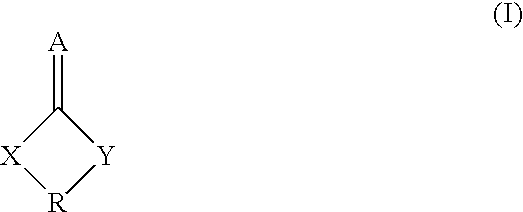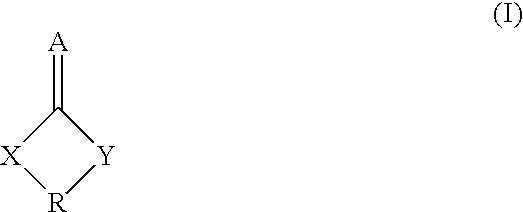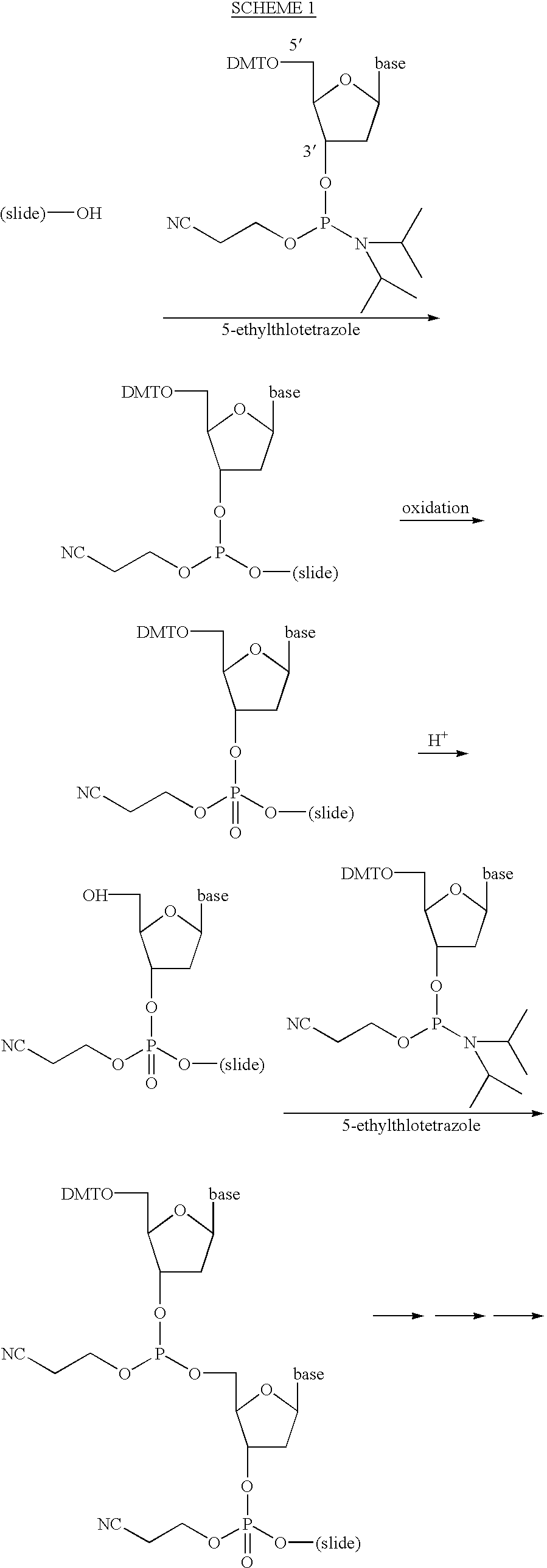Chemical synthesis using solvent microdroplets
a technology of microdroplets and solvents, applied in the field of chemical synthesis, can solve the problems of reactants dissolved in solvents clogging inkjet nozzles, affecting the synthesis efficiency of biopolymers, and causing the formation of unstable and non-uniform droplets
- Summary
- Abstract
- Description
- Claims
- Application Information
AI Technical Summary
Problems solved by technology
Method used
Image
Examples
example 1
6. EXAMPLE 1
Comparison of Result of Oligonucleotide Synthesis With Propylene Carbonate vs. Acetonitrile Solvent
Nucleoside phosphoramidites used in this experiment are of the EXPEDITE.TM. type, and were obtained from Perseptive Biosystems, Framingham, Mass. The primary amino groups of the base portion of the adenosine (A), cytidine (C) and guanosine (G) nucleosides were protected with t-butylphenoxyacetyl (tBPA) groups. The 5'-hydroxyl groups of the A, C, G and thymidine (T) nucleosides were protected with a dimethoxytrityl (DMT) group. The 3'-hydroxyl groups of the A, C, G and T nucleosides were derivatized as .beta.-cyanoethyl-N,N-diisopropylphosphoramidites.
This example compares the efficiency of nucleoside coupling when propylene carbonate is used as a reaction solvent, relative to that when acetonitrile is used, in conventional, solid phase nucleoside synthesis.
As shown below in Table 1, eight separate oligonucleotide homopolymers of A, T, C and G, each being eleven nucleotides ...
example 2
7. EXAMPLE 2
Synthesis of Two-Dimensional Oligonucleotide Arrays Using an Inkjet Print Head
This example describes the synthesis of a two-dimensional array of oligonucleotides using the synthesis system described in Section 5.5.1. With respect to the steps involving deposition of reagents using an inkjet printing head, i.e., those steps not involving oxidizing, rinsing, capping and deprotection, an earlier version of the software described in Section 5.5.2 was used.
The nucleoside phosphoramidites used in this experiment were those described in Section 6, above.
An oxidizing solution, that was used to oxidize nucleoside phosphite triesters to nucleoside phosphate triesters, consisted of 90.54% (v / v) tetrahydrofuran, 9.05% (v / v) water, 0.41% (v / v) pyridine and 4.3 g / L iodine.
As mentioned before, inkjet print heads used herein were EPSON STYLUS COLOR II.TM. color heads, available from the manufacturer as spare parts, which consist of three banks of twenty nozzles each. All of the nozzles ...
PUM
| Property | Measurement | Unit |
|---|---|---|
| surface tension | aaaaa | aaaaa |
| boiling point | aaaaa | aaaaa |
| volume | aaaaa | aaaaa |
Abstract
Description
Claims
Application Information
 Login to View More
Login to View More - R&D
- Intellectual Property
- Life Sciences
- Materials
- Tech Scout
- Unparalleled Data Quality
- Higher Quality Content
- 60% Fewer Hallucinations
Browse by: Latest US Patents, China's latest patents, Technical Efficacy Thesaurus, Application Domain, Technology Topic, Popular Technical Reports.
© 2025 PatSnap. All rights reserved.Legal|Privacy policy|Modern Slavery Act Transparency Statement|Sitemap|About US| Contact US: help@patsnap.com



